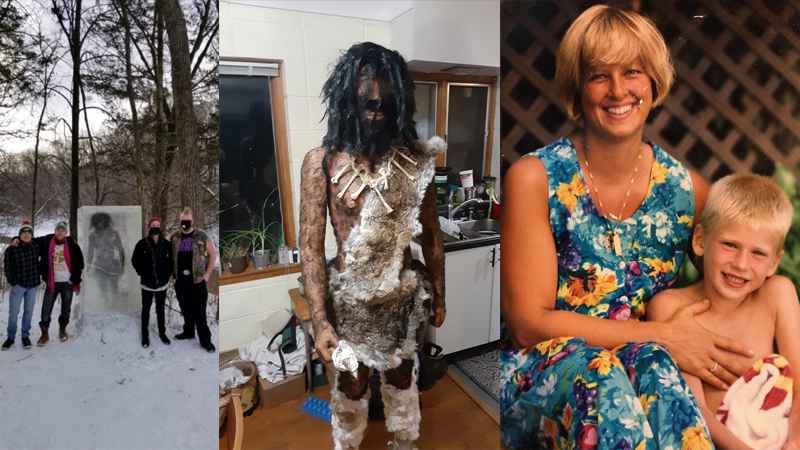A mysterious appearance by a fictional caveman draws visitors to Theodore Wirth Park– and now the hunt is on for his female companion
[anvplayer video=”5001325″ station=”998122″]
On a cold, beautiful day in Theodore Wirth Park, visitors were busily skiing, hiking and even bicycling on the snowy trails.
And… oh yes, visiting with a fictional caveman named ‘Zug Zug.’
"We hoped to bring a little joy into people’s lives," explains Ian Molloy-Busse, a sculptor with the Leonic Art Collective. "Maybe give them a reason to get out and about in this beautiful park and hopefully put a smile on somebody’s face."
Just weeks ago, Zug Zug— made of clay and encased in a block of very realistic fake ice, made of Plexiglas and epoxy— mysteriously appeared at a publicly undisclosed location inside the park.
But for intrepid park users and amateur detectives, finding Zug Zug has been a nice distraction from all that’s going on in the world.

Zug Zug, Leonic Collective, Zach Schumach and Rachel Lundstrom
"It’s part of the fun, is the hunt," Molloy-Busse says. "Zug Zug had been out here for a little bit before anybody posted him on Instagram."
Indeed, this caveman celebrity is now a viral and selfie sensation.
"It’s fun, we love to see art anywhere in the outdoors," smiles John Rock, of Minneapolis. "We especially loved how it just showed up and people get to discover it."
Zug Zug is the creation of Minneapolis-based artist Zach Schumack and his art collective, Leonic.
The hirsute figure’s first appearance was at an advertising industry show last year.
But afterward, he was stored in Schumack’s garage— at least for a while.
"He was in storage and we just kept seeing him man, and thinking about how much fun it was to make, how much fun he was to look at," Molloy-Busse recalls.
So after getting clearance from the Minneapolis Park and Rec Department, the Leonic team brought Zug Zug to a secret location, and let people discover him.
"I like the unexpected surprise of having it show up in the park," says Marjorie Fedyszyn, who lives nearby. "That it’s so authentic. That we have to wonder about it and we need more wonder in our lives."
But Zug Zug’s creators started thinking— maybe he needed a companion.
"Exactly, everybody gets a little lonely," Molloy-Busse says. "Especially these days and we thought Zug Zug needed somebody else in his life, so… Zarah."
Crowds gawk at caveman installation at Theodore Wirth Park
The artists wouldn’t show us a photo of what Zarah looks like, or even where she is.
We were assured she looks very much like her male counterpart, but more feminine, of course.
The Leonic team will only say she is in a public park somewhere in Minnesota.
"There’s a love story here," Molloy-Busse says. "He’s got a partner out here somewhere in Minnesota, and she and him, they’re together, through thick and thin, through ice and time."
"I hope they find each other," Fedyszyn smiles. "There had to be Neanderthal romances, right? Because we exist."
There is a poignant part of this story.
Schumack created Zarah to honor his mother, Rachel Lundstrom, who raised him alone, until she died of breast cancer, when he was just eight-years-old.
"We wanted to show a woman who embodied the spirit of perseverance, who embodied feminine power," Molloy-Busse says quietly. "Who wasn’t giving up and who wouldn’t give up. Somebody who would fight to the end."
Whether it’s the hunt for Zarah, or the discovery of Zug Zug— park visitors are interested— and fascinated.
That includes Kristin Lyon, of Minneapolis, and her canine pal ‘Tater Tot.’
"I heard about it and wanted to come check it out," Lyon says. "Try to keep him cultured and want him to learn about history, it’s important," she laughs.
After Zarah is located, her creators plan to release a children’s book about her and Zug Zug’s love story.
"We want people to look at this as a story of joy, of hope, of perseverance," Molloy-Busse says. "We want to show that all individuals can work together and can come together, even though hardships in order to build a perfect life."
"I love that even as adults, that there’s creativity that can be expressed," Lyon adds. "And this is a cool way of bridging nature, and creativity, and wonder."